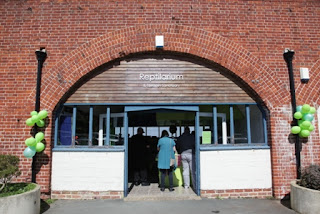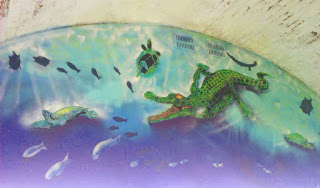Through an unassuming entrance lies 4 rooms of biodiversity: Desert, Jungle, a Terrapin Pool and a Nocturnal Room with reptiles as rare and diverse as Moroccan Uromastyx to Painted Wood Turtles.
 |
| Entrance to Reptilarium and Terrapin Sanctuary |
With anticipation, I stepped through the green doors to find myself in the desert with some living stones, South African succulent plants with a stone-like appearance.
 |
| Living Stones display |
To my left and right was a row of vivariums, each one individually climate controlled to the ideal temperature for its inhabitants.
I peered into the enclosure at hollowed logs strategically placed in the wood chip, vines angled against the wall for optimum climbing and perfect camouflage, succulents taking root in their new environment. Something on the branch moved then froze again. An untouched bowl of food lay at the front of the vivarium and then an eyeball looked around and I noticed just how effective the camouflage was as I followed the eye of the tiny lizard down to the tip of his tail.
"Ah he's out now," said one of the friendly, green t-shirted volunteers. The volunteers were extremely helpful and knowledgeable. They turned what at first appeared to be a lifeless glass box into a world full of interest and on almost every occasion could spot the resident or residents inside.
 |
| One of the residents popping out for a look |
Luckily, the reptile centre operates a hand stamp system allowing visitors to return as often as they like throughout the day so they can pop back and see if the spiny-tailed monitor has crawled out from under his rock or the hispaniolan curlytail lizard has been tempted by his leafy lettuce.
 |
| Individually Climate Controlled Vivarium |
In the large terrapin pool, there are currently 30 terrapins of varying ages and size and it is hoped that they will be able to rescue up to 100 yellow-bellied slider turtles altogether. The terrapins will not be allowed to breed but they can lay their eggs in a sand box at the side of the pool allowing them to lead as natural a life as possible and prevent them becoming egg bound.
With so much to see and do at Fort Victoria, including the Planetarium, The Sunken Secrets Archaeological Centre and the Model Railway, you can easily spend a whole day there, exploring the beaches for fossil turtle and alligator, following the nature trail through the country park or taking in the views over The Solent to Hurst Castle and Lymington from the roof of the old fort batteries giving you plenty of opportunity to pop back to the Reptilarium to see if that elusive snake, lizard, cockroach or scorpion has ventured into view.
 |
| Alligator and Turtle murals on the Fossil Art Trail at The Reptilarium at Fort Victoria |
You will also find another part of the Fossil Art Trail on show at the reptile centre. A mural by Tony Trowbridge depicting images of the turtles and alligators that used to swim in the waters in that area and whose fossils can now be found on the beaches around the fort is on show in the gift shop of the Reptilarium.

No comments:
Post a Comment